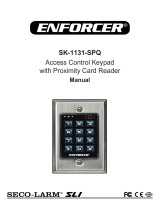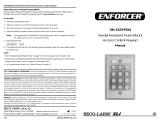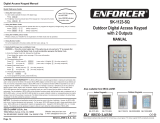
4
ENFORCER Access Control Keypad
SECO-LARM U.S.A., Inc.
Table of Contents:
Quick Installation Guide ..................................................................................................................... 2
Mounting Diagram ............................................................................................................................. 2
Quick Wiring Diagram ........................................................................................................................ 2
Quick Programming Guide ................................................................................................................ 3
Table of Contents ............................................................................................................................... 4
Features ............................................................................................................................................ 5
Specications .................................................................................................................................... 5
Overview ............................................................................................................................................ 5
Parts List ............................................................................................................................................ 5
LED Indicators and Keypad Sounds .................................................................................................. 6
Installation ......................................................................................................................................... 7
IMPORTANT NOTES ........................................................................................................................ 7
Wiring Diagram .................................................................................................................................. 8
Sample Applications .......................................................................................................................... 8
Getting Ready to Program ................................................................................................................. 9
Programming Format and Default Programming Values ................................................................. 10
System Restore ................................................................................................................................11
Programming the Master Code ........................................................................................................11
Programming the Super User Code .......................................................................................... 12~13
Programming User Codes ............................................................................................................... 14
Programming Visitor Codes ............................................................................................................. 15
Programming the Output Mode and Output Timing ......................................................................... 16
Programming the Real-Time Clock ................................................................................................. 17
Programming the Auto-Disable Time ......................................................................................... 18~19
Programming the Wrong-Code System Lock-Up ............................................................................ 19
Programming the User Code Entry Mode ................................................................................. 19~20
Programming the Keypad Sounds ................................................................................................... 20
Programming the Output Relay Activation Sounds ......................................................................... 20
Programming the Amber LED Flashing during Standby Mode ........................................................ 21
Programming the Egress Delay/Warning .................................................................................. 21~22
Direct Access to Programming (DAP) ............................................................................................. 23
Notes ............................................................................................................................................... 23
User’s Guide to Operating the SK-1011-SDQ ................................................................................. 24
Also Available .................................................................................................................................. 24


























